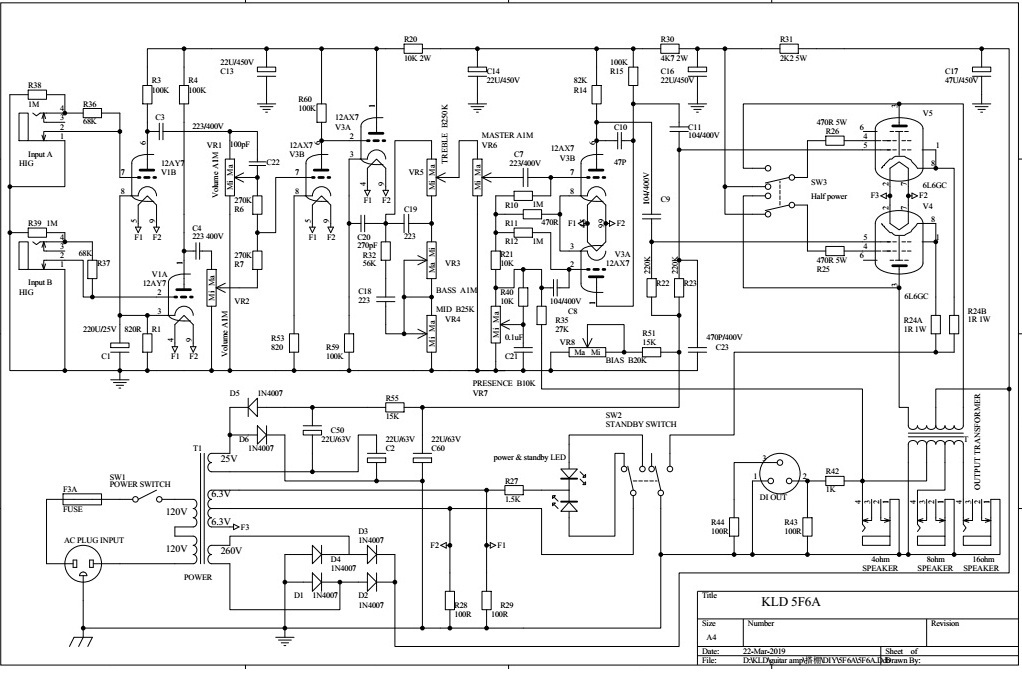The Bassman25 was never meant to be ultra-clean - it was built for punchy bass response and smooth transition into overdrive. That's the tone the Marshall JTM45 copied - it's the Sweet, Clean, Dynamic, big low end , but it breaks up relatively early once the volume is past 4-5, especially with modern hot pickups or when using guitar speakers, not the "Twin Reverb" clean.
You can made Bassman 25 have a bit more headroom. But because its overall circuit architecture already runs near the limit of what 6L6 tubes and that power supply can deliver, so you can make it a bit cleaner and louder,but not dramatically more.
- Increase B+ voltage slightly.
: Raises plate voltage and tightens bass. - Use 5881 or 6L6GC tubes with strong plate dissipation ratings.
- Increase filter capacitors:
- First stage: from 16 µF to 40 µF
- Screen node: from 16 µF to 22 µF
: Reduces sag and hum. - Use larger grid stoppers on phase inverter (PI) (e.g., 68 kΩ to 100 kΩ).
Slightly smooths distortion and stabilizes the circuit.

If you want the Bassman 25 to behave more like a Marshall or to get earlier breakup.It is easy to do , you can modify preamp or tone stack below :
- Change V1 cathode resistor R1:
- From 820 Ω to 1.5 kΩ (like early Marshalls) for a little more gain.
- Use 1 µF cathode bypass cap for more low-end gain.
- Use smaller cathode bypass capacitor C1 on second gain stage:
- 250 µF to 0.68 µF (Marshall-style mid emphasis).
- Increase coupling caps C3, C4 on preamp to get thicker distortion.
- Example: 0.022 µF to 0.047 µF or 0.1 µF between stages.
- Tighten feedback loop:
- Change feedback resistor R35 from 27 kΩ to 47 kΩ or 100 kΩ to reduce feedback and increase gain.
- Install a pre-phase-inverter master volume (PPIMV) - lets you overdrive power tubes at lower volume.
The original Bassman 25 is smooth and wide-band. Certainly , if you want get a tighter, more aggressive sound, you can try to modify it according to below instructions:
- Bright cap on Volume pot VR2: Add 100 pF- 250 pF cap across the bright channel volume pot adds sparkle at low volume.
- Tone stack tweaks:
- Mid resistor R32: 56 kΩ to 33 kΩ (more mids, Marshall-like)
- Bass cap C19: 0.1 µF to 0.022 µF (tightens low end)
- Treble cap C20: 250 pF to 470 pF (more high bite)
- Presence cap C21: 0.1 µF to 0.68 µF or 1 µF for more high-end punch.
- Smaller coupling caps in output stageC9, C11: 0.1 uF to 0.022 uF.
- Increase negative feedback (NFB)R35 (reduce resistor value to 22 kΩ) for tighter feel.
If you want to record directly from the amp:
- Add transformer-isolated line out (post OT):
- Use a small DI transformer (Jensen, Lundahl, or Edcor) tapped from the speaker output with a 100 kΩ load resistor.
- Include a -15 dB pad and ground lift for safety.
- Optional: Add "Pre/Post EQ" switch before or after tone stack for flexible DI tone.
- This can be drawn in a simple one-page wiring diagram (I can make you a printable PDF for this if you want).
- Link Normal & Bright channels (jumper inputs) for thicker tone.
- Convert Normal channelto a lead channel:
- Change tone stack to fixed mid boost (remove mid pot, use 6.8 kΩ fixed resistor).
- Add small bypass cap (0.68 µF) on cathode for more bite.